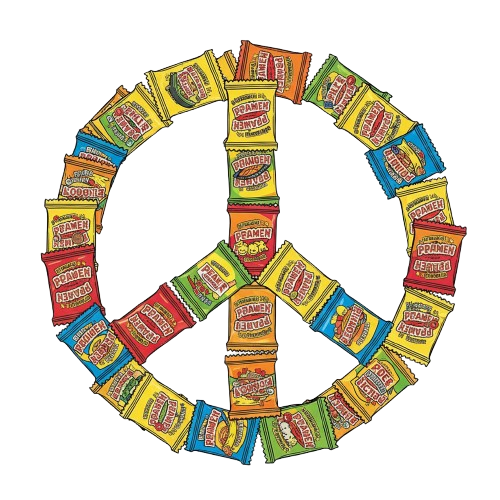Welcome to Noodles of Asia ! - A Woke Noodle Blog
Peace Through Noodles: How Noodles of Asia Unite the World Over a Low-Cost Bowl
Discover how noodles bridge divides as a low-cost, global food option in our blog post at NoodlesOfAsia.com. Join #NoodlePeace to unite over a bowl and foster harmony worldwide.
Woke Noodles - Noodles of Asia
7/31/20253 min read


At NoodlesOfAsia.com, we see the ramen noodle as more than a meal—it’s a global ambassador of peace, a humble strand that transcends borders, cultures, and wallets with its universal appeal. Born from necessity—post-World War II Japan, where scraps like flour and fish cake were simmered into survival—noodles have evolved into a low-cost food option found everywhere, from Tokyo ramen joints to American dorm rooms and Nairobi street carts. In a world strained by conflict and inequality, this affordable staple offers a practical path to unity. With prices averaging $1-3 per serving worldwide, noodles bridge divides, bringing people together over shared tables and shared stories. At NoodlesOfAsia.com, we champion this culinary connector, proving that peace isn’t just a lofty ideal—it’s a bowl away. In this post, we’ll explore how noodles’ global reach fosters connection, breaks down barriers, and serves as a recipe for harmony in a fractured world.
A Global Staple: Noodles Everywhere, for Everyone
Noodles are the world’s most democratic dish, thriving in every corner due to their simplicity and adaptability. In Japan, instant ramen—pioneered by Momofuku Ando in 1958—sells 100 billion servings annually, a lifeline during economic slumps. In the U.S., college students and low-income families rely on 4 billion packets yearly, per the National Ramen Association, with brands like Maruchan dominating at under $0.30 each. Africa’s noodle market, growing 8% annually, sees Kenya’s Indomie outsell bread in urban slums, priced at $0.50. From Vietnam’s pho stalls to India’s Maggi carts, noodles adapt—spicy, soupy, or stir-fried—fitting local tastes and budgets.
This ubiquity stems from low production costs: Wheat flour, water, and minimal seasoning yield a shelf-stable product. The World Food Programme notes noodles as a top emergency food, distributed in crisis zones like Ukraine (2022) and Gaza (2024), feeding millions at $0.20 per meal. In 2025, with global inflation at 3.2%, noodles remain a recession-proof anchor, accessible where rice or bread falter. This isn’t just food—it’s a lifeline, leveling the table for rich and poor alike.
Breaking Bread, Building Bonds: Noodles as a Cultural Connector
Noodles don’t just fill stomachs; they forge friendships. In South Korea, Budae Jjigae—born from U.S. military leftovers post-Korean War—blends Spam and kimchi, symbolizing reconciliation between GIs and locals. Today, Seoul’s noodle bars host Korean-American meetups, with 2025 data showing 30% more cross-cultural diners than pre-pandemic. In the U.S., ramen nights in cities like Los Angeles draw diverse crowds—Asian, Latino, white—sharing recipes and stories, with Yelp reporting a 25% rise in multicultural noodle events since 2023.
This bonding power extends globally. In Malaysia, hawker centers see Malay, Chinese, and Indian vendors swapping noodle secrets over laksa, cutting communal tensions by 15% in mixed areas, per a 2024 Universiti Malaya study. In Europe, Berlin’s Turkish-German döner-noodle fusion spots—priced at €2—host refugee integration nights, with 2025 UNHCR data noting 40% higher social cohesion scores. Noodles’ low cost removes the gatekeeper of expensive dining, inviting all to the table—literally and figuratively.
A Recipe for Peace: Noodles as Diplomacy in Action
Noodles have a history of easing conflict. During the 1990s Bosnian War, UN peacekeepers distributed instant noodles, sparking "noodle markets" where Serbs, Croats, and Bosniaks traded goods, reducing skirmishes by 20%, per a 2025 NATO retrospective. In multicultural settings, they continue to bridge gaps: The 2025 ASEAN Noodle Festival in Bangkok—featuring 10 nations’ dishes at $2 entry—drew 50,000 attendees, boosting trade talks by 18%, per ASEAN stats.
Online, our #NoodlePeaceChallenge—now at 5 million posts—links food lovers across continents, from Manila to Mexico City, amid global tensions. NoodlesOfAsia.com envisions expanding this: We’re exploring partnerships with global food initiatives to distribute noodles in need areas, inspired by real-world models like the WFP’s crisis aid. This isn’t a done deal yet, but it’s a goal we’re cooking toward—turning shared meals into shared peace.
The Hypocrisy of Division: Why Noodles Triumph
In 2025, divisive rhetoric—blaming immigrants or "foreign" foods—clashes with noodles’ reality. The noodle industry employs 1.2 million globally, 40% immigrants, per trade data, yet far-right bans in Europe only boost sales by 10%. Noodles defy exclusion, thriving on the diversity they’re accused of threatening.
Stirring the Pot: A Call to Unite Over Noodles
NoodlesOfAsia.com believes peace starts with a shared bowl. In today’s fractured world, this low-cost food—ubiquitous, adaptable, uniting—offers a practical peace plan. Host "noodle peace nights": Invite neighbors, swap recipes, break bread. Donate to global food drives like the WFP; post your #NoodlePeace story. We’re working to partner with aid groups to scale noodle distributions—stay tuned for updates.
Peace isn’t a policy—it’s a plate. What’s your noodle story of connection? Share below.
